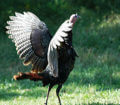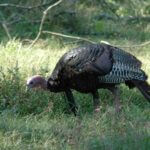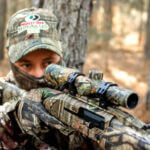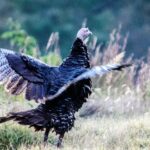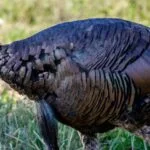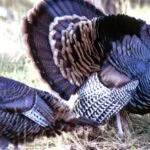John’s Note: As a youngster, J.R. Keller grew up in Delta, Colorado, and acquired a love for the outdoors from his father as he fished, hunted and camped with him. Through the years, Keller found a passion for turkey hunting that would consume most of his free time and lead him to become an avid turkey hunter and competition caller. This week we’re talking with J.R. about his turkey-hunting tactics.
1) How do you handle a hung-up turkey?
Keller: Terrain dictates the tactic required to take a turkey that won’t come into gun range. Hunting in the West where I live, we have a vast amount of open terrain that prevents a hunter from circling the turkey like he will in the East. Many times if you try to change your calling position when the turkey hangs-up, the bird will see you and become spooked. To prevent a turkey from hanging-up, I get as close as I can to the tom before I start to call. Then I can watch the turkey as I call to him and determine what effect each one of my calls is having on that gobbler. Often if I can get close enough to the turkey to watch him respond to the calls when he refuses to come in, then I’ll realize a creek, a ditch, a fence or other obstruction is between the turkey and me that that bird doesn’t want to cross. I’ll quit calling, let the turkey walk off and watch the direction he’s going. When I’m sure he can’t see me, then and only then will I try and change positions, circle the turkey, get in front of him, change calls and make another attempt to call him.
 2) What call do you recommend to use to locate a turkey?
2) What call do you recommend to use to locate a turkey?
Keller: I don’t use a turkey call to locate a gobbler, but prefer instead to use a crow call. A crow call will usually produce a shock gobble no matter where you’re hunting, which gives away the gobbler’s position. Once I know where the turkey is, then I can decide where I need to take a stand and begin to call. I believe that locating a turkey first is the most-important element of finding and taking a turkey. If I only have one call to hunt with, I’ll take the crow call with me. The crow call allows you to not only know where the turkey is but also helps you keep up with the direction the turkey is moving and know where you have to set-up to take that turkey.
3) How do you handle a gobbler with hens?
Keller: The real secret to taking a turkey with hens is not to hunt the gobbler when he’s with hens. Most of the henned-up gobblers you’ll encounter will be the first thing in the morning because the first thing a gobbler wants to do when he leaves the roost is to get with his hens. Remember that the reason a turkey gobbles in the morning is to call his hens to him. Often the gobbler on the roost will see his hens on the ground before he flies off the roost – especially older gobblers will do this. If I know a gobbler has hens with him, or that the first morning or two I’ve hunted that gobbler he’s had hens with him, instead of going to that tom at daylight, I’ll wait until 9:00 or 10:00 am to start hunting that bird because later in the morning he’ll be easier to call. I can consistently take more gobblers from 9:00 am until 12:00 noon than I can at any other times of the day. I take the fewest number of turkeys from daylight until 9:00 am. I think one of the problems we’ve created for ourselves is that we go into the woods before daylight to hunt turkeys because we’ve always gone into the woods before daylight to hunt. We love to hear turkeys gobble from the roost, and we like to try and take them when they fly down off the roost. However, this time is when more than likely, he’ll be with his hens, and we’ll have the least chance of calling that bird to us. If we change our hunting tactics and don’t start hunting the turkey until about 9:00 am, we’ll have a much-better chance of calling him in, and the odds will be much greater that he won’t have hens with him.
 4) Because you hunt turkeys in the West, you’re also often hunting turkeys in the mountains. What do you do when you start calling, and a gobbler answers you, but the turkey is on a different mountain from the mountain you’re calling?
4) Because you hunt turkeys in the West, you’re also often hunting turkeys in the mountains. What do you do when you start calling, and a gobbler answers you, but the turkey is on a different mountain from the mountain you’re calling?
Keller: When I locate a turkey on a mountaintop, I feel I have a responsibility to go to that turkey. I don’t try and bring that turkey to me. For instance, a lot of obstructions may be between me and the turkey to prevent the gobbler from coming to me. Therefore, when I locate the gobbler, I’ll do whatever I have to do to get on the same mountain with him. I want to shorten the distance that I am from the turkey and allow the bird to come to me along a route he’ll walk with no obstructions between us. If there’s a creek or a fence between me and the turkey, I’ll cross the creek or climb the fence. If there’s a blown-down tree between me and the longbeard, I’ll get on the turkey’s side of the tree. If the turkey’s above me, I’ll climb the mountain to get on the same level with him. If the turkey’s gobbling below me, I’ll slide down the mountain and get on the same level with the turkey.
If you can make the distance a turkey has to come to you a short and easy walk for him, your odds are much greater for taking him. If the turkey’s in a place you don’t want to go, then you have one of two choices. You either go to the spot you don’t want to go to and try and take that turkey, or, you can leave that turkey and go look for another bird to hunt.
5) How do you decide how much to call to a turkey, and how do you know if you’re calling too much or too little to a gobbler?
Keller: Each time a turkey gobbles, he’s telling you how to call to him. For instance, if I call to a turkey, and he gobbles back immediately, I’ll call to him again. If I continue to call to the turkey, and he gobbles back to me but isn’t moving toward me, then I assume that gobbler has hens with him. I know I’ll either have to change my calling position or change the way I’m calling to that bird. Once I’ve established that the bird is staying in the same place, then when he gobbles back to me, I assume he’s got hens with him. So, I’ll use a variety of calls, including a box call, either a slate or a glass call, and several different diaphragm calls. Instead of sounding like a single turkey hen, I want to sound like a flock of turkeys. The gobbler probably won’t leave his harem to come meet one hen. However, he may hear his harem calling in the same direction of my calling, which he believes to be another flock of hens.
 One of the joys of turkey hunting comes when you can get inside the mind of that tom. If you can learn what he’s thinking and what he plans to do, then you can know how to call and when to call to him. I try and let the turkey tell me how much hen talk he wants to hear. I have a tendency to call less than many other hunters do. I prefer to be more subtle with my calling. I like to change directions with my calling or move to another calling spot rather than call aggressively to the turkey with cuts, cackles and loud yelping. For me, aggressive calling is my last-ditch chance to call in a turkey. I don’t want to call aggressively to a turkey unless all my other calling tactics have failed.
One of the joys of turkey hunting comes when you can get inside the mind of that tom. If you can learn what he’s thinking and what he plans to do, then you can know how to call and when to call to him. I try and let the turkey tell me how much hen talk he wants to hear. I have a tendency to call less than many other hunters do. I prefer to be more subtle with my calling. I like to change directions with my calling or move to another calling spot rather than call aggressively to the turkey with cuts, cackles and loud yelping. For me, aggressive calling is my last-ditch chance to call in a turkey. I don’t want to call aggressively to a turkey unless all my other calling tactics have failed.
To learn more about turkey hunting, check out John E. Phillips’ print, Audible, Kindle and Nook turkey books at https://johninthewild.com/books/#turkey and at www.barnesandnoble.com. You also can download a free Kindle app that enables you to read the book on your iPad, computer or SmartPhone. You can learn more about calling turkeys by going to johninthewild.com/audio-files/ for audio turkey tapes to purchase of Lovett Williams, Rob Keck and Chris Kirby, available for download to your SmartPhone, tablet or computer. For a free copy of John E. Phillips’ “The Turkey Gobbler Getter Manual,” go to https://johninthewild.com/free-books/ to download.


